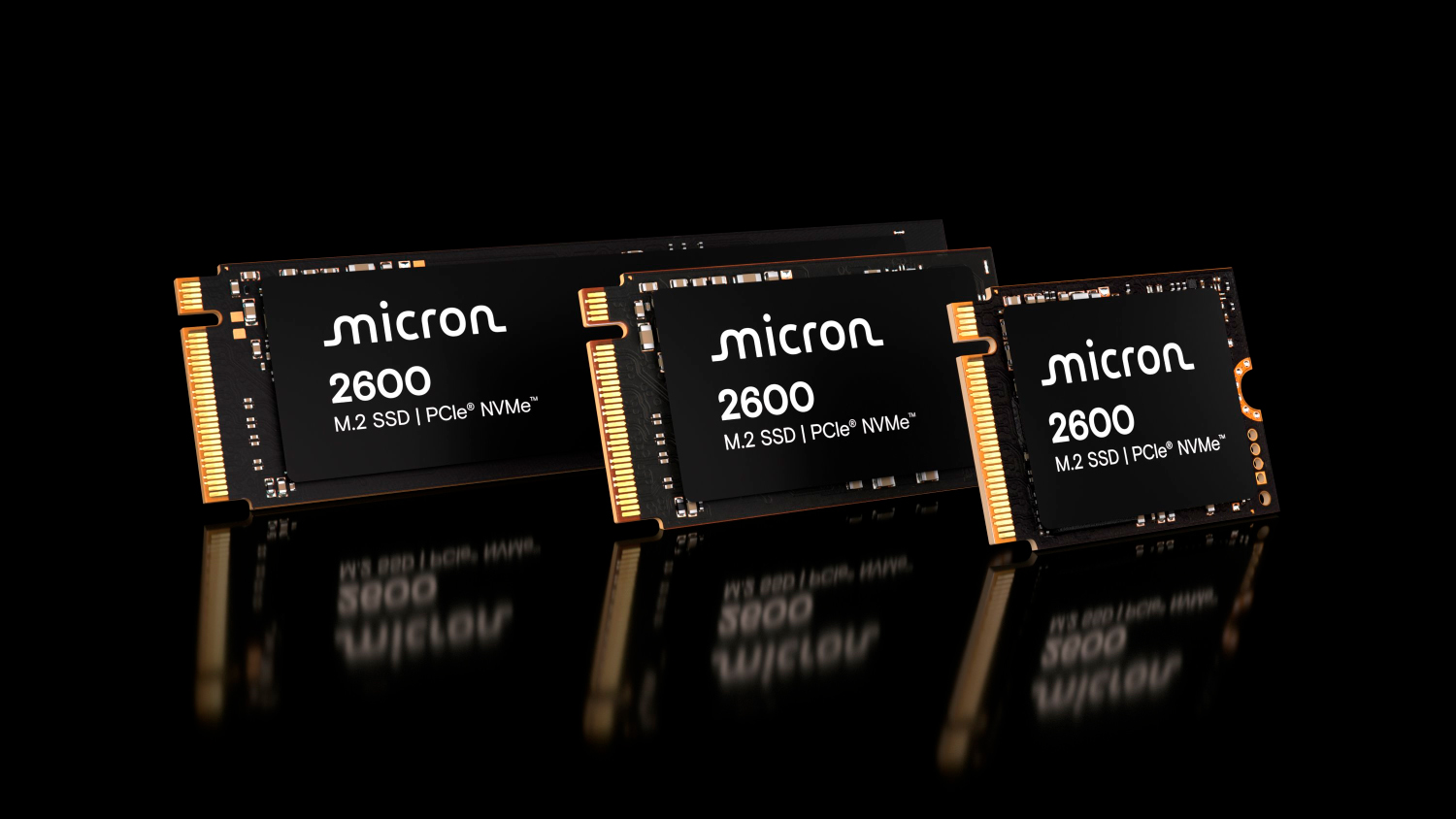Micron 2600 QLC SSD uses flexible caching to offer TLC-like performance—7,200 MB/s reads and 6,500 MB/s writes push the limits of PCIe 4.0

Micron has introduced a new client SSD designed for OEMs that competes with the best SSDs on the retail market. The Micron 2600 is available in three distinctive form factors, providing top-tier PCIe 4.0 speeds across various storage capacities.
Micron has combined Phison's PS5029-E29T SSD controller with the company's own 276-layer G9 QLC NAND in a DRAMless design. The manufacturer has implemented its Adaptive Write Technology (AWT) in the Micron 2600 series, which boosts SSD performance by using various NAND modes (SLC, TLC, and QLC) as a dynamic cache to improve sustained QLC write performance.
Adaptive Write Technology starts by writing new data in SLC mode. Once SLC is full, it switches to TLC mode. After both SLC and TLC are filled, the technology moves the data to QLC mode when the SSD is idle. Finally, it frees up the SLC and TLC regions to store new data. By switching between NAND modes, Adaptive Write Technology ensures the drive offers the fastest possible write performance.
Micron 2600 SSD Specifications
Capacity | Sequential Read (MB/s) | Sequential Write (MB/s) | Random Read (IOPS) | Random Write (IOPS) | Read latency (TYP) | Write latency (TYP) | Endurance (TBW) | Sleep/PS4 power (mW) | Active idle power (mW) | Active read power (mW) |
|---|---|---|---|---|---|---|---|---|---|---|
2TB | 7,200 | 6,500 | 1,000,000 | 1,100,000 | 50 µs | 12 µs | 700 | < 2.5 | < 100 | < 5,000 |
1TB | 7,299 | 5,800 | 740,000 | 1,000,000 | 50 µs | 12 µs | 400 | < 2.5 | < 100 | < 5,000 |
512GB | 5,000 | 3,000 | 370,000 | 690,000 | 50 µs | 12 µs | 200 | < 2.5 | < 100 | < 5,000 |
The Micron 2600 is available in 2230, 2242, and 2280 form factors, featuring a single-sided design. Consequently, the drive accommodates a comprehensive range of devices, including desktops, laptops, and handheld gaming consoles such as the Steam Deck or the Lenovo Legion Go. Customers may select from three storage capacities: 512GB, 1TB, or 2TB. There are no mentions of a 4TB or 8TB model.
In terms of performance, the Micron 2600 can achieve sequential read and write speeds of up to 7,200 MB/s and 6,500 MB/s, respectively. Its random read and write speeds reach maximums of 1,000,000 IOPS and 1,100,000 IOPS, respectively. However, these specifications are exclusive to the highest capacity model. The 1TB and 512GB variants exhibit slightly reduced performance metrics. The read and write latencies are decent and uniform across all three capacities.
The endurance of the Micron 2600 commences at 200TBW for the 512GB variant and extends to 400TBW and 700TBW for the 1TB and 2TB models, respectively. The endurance level corresponds with that of conventional QLC SSDs, and thus, is not exceptionally remarkable.
Micron has already started shipping the different flavors of the Micron 2600 to OEMs. Logically, the pricing and warranty period vary between the OEMs.
Get Tom's Hardware's best news and in-depth reviews, straight to your inbox.
Follow Tom's Hardware on Google News to get our up-to-date news, analysis, and reviews in your feeds. Make sure to click the Follow button.

Zhiye Liu is a news editor, memory reviewer, and SSD tester at Tom’s Hardware. Although he loves everything that’s hardware, he has a soft spot for CPUs, GPUs, and RAM.
-
Giroro Flexible caching sounds like something that will make a brand new drive look better in a short term review, while not really being beneficial to a real user using a typically-loaded drive.Reply
I'd call that cheating, or at least misleading -
Mr Majestyk Reply
And crappy capacities to further put this in the instant fail basket. Tell me again why we introduced QLC rubbish when it can't even offer higher capacity than TLC after all this time. With 8TB TLC drives widely available, I was expecting 16TB QLC drives by now.Notton said:Oomph, those endurance numbers... -
Vanderlindemedia ReplyNotton said:Oomph, those endurance numbers...
In a typical desktop enviroment you won't be running out of those even after it's considered lifespan. -
Notton Reply
Theoretically they shouldn't, but there are people that like to fill their drives to >90% of capacity, something you shouldn't do with SSDs.Vanderlindemedia said:In a typical desktop enviroment you won't be running out of those even after it's considered lifespan.
Having <16GB RAM has the effect of more page file usage, further increasing wear rate, and is surprisingly too common in cheapo laptops. -
Vanderlindemedia ReplyNotton said:Theoretically they shouldn't, but there are people that like to fill their drives to >90% of capacity, something you shouldn't do with SSDs.
Having <16GB RAM has the effect of more page file usage, further increasing wear rate, and is surprisingly too common in cheapo laptops.
I'm using primocache in combination, with a UPS.
Primocache offers the option to stall the writing to pagefile and saves it in RAM before it does that every, lets say 300 seconds. Advantage is a must healthier SSD, quite snappy OS and less wear long run.
UPS is needed because if power does cut out, your in a world of trouble if the writeback did not succeed. -
bit_user Reply
I'm pretty sure we've seen behavior like that, in the "sustained write" benchmarks, in SSD reviews. There are definitely drives which have more than 2 tiers of write speeds.The article said:Adaptive Write Technology starts by writing new data in SLC mode. Once SLC is full, it switches to TLC mode. After both SLC and TLC are filled, the technology moves the data to QLC mode when the SSD is idle. Finally, it frees up the SLC and TLC regions to store new data. By switching between NAND modes, Adaptive Write Technology ensures the drive offers the fastest possible write performance. -
bit_user Reply
I'd agree, except that I think most people tend to run their SSDs close to max capacity, for at least a significant amount of their lifespan. The size of the caches is proportional to how much free space you have, in which case it's worth having that TLC tier because the SLC cache of a nearly-full drive would be small enough that it wouldn't be hard to fill it.Giroro said:Flexible caching sounds like something that will make a brand new drive look better in a short term review, while not really being beneficial to a real user using a typically-loaded drive. -
bit_user Reply
I dunno. I had a couple situations where Firefox was generating several TB of host writes per day. I noticed my disk LED continually flashing and checked to see what was causing it. I think it was one or more web pages, continually writing lots of cookies.Vanderlindemedia said:In a typical desktop enviroment you won't be running out of those even after it's considered lifespan. -
bit_user Reply
Yeah, but it depends on how sophisticated the wear-leveling is. Ideally, the SSD should be periodically refreshing its blocks and migrating data to even out wear, in the process.Notton said:Theoretically they shouldn't, but there are people that like to fill their drives to >90% of capacity, something you shouldn't do with SSDs.